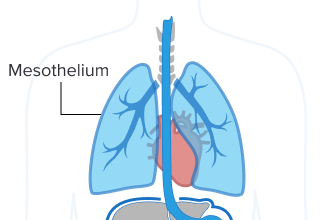
Dr. Andrea Wolf is the Director of the New York Mesothelioma Program at Mount Sinai in New York City. She focuses on multidisciplinary treatment, clinical research, community outreach and education.
The mesothelium is a slippery, protective membrane of flattened mesothelial cells that line the lungs, abdomen, heart and testes. Mesothelioma cancer can develop in the mesothelium because of asbestos exposure.

The mesothelium is a thin membrane made of specialized cells called mesothelial cells. This membrane protects organs and is where mesothelioma, a cancer affecting this tissue, develops. It helps your body react to injuries and diseases.
The mesothelium moves serosal fluid, a slippery liquid that lowers friction, across body cavities. It also controls inflammation, which is your body’s response to injury or infection. Doctors name these membranes based on the organs they cover.
Learn about your diagnosis, top doctors and how to pay for treatment in our free mesothelioma guide.
Get Your GuideLocations of the Mesothelium
When you inhale asbestos fibers, they can stick in the mesothelium. These fibers irritate and damage soft tissue over time. The lymphatic system, which removes waste and fights infections, carries asbestos fibers deeper into mesothelial layers. Asbestos causes malignant mesothelioma, lung cancer, asbestosis (lung scarring) and other diseases.
The mesothelium has 2 layers: visceral and parietal. The visceral mesothelium covers your internal organs. The parietal mesothelium covers your serosal cavity, which is the space around those organs where serosal fluid moves.
Serosal fluid contains proteins and cells that help repair tissue or respond to inflammation, supporting the mesothelium’s protective role. Although the mesothelium protects your body, its tissue renews slowly. Less than 1% of mesothelial cells divide at any time.
Functions of the Mesothelium
Research on immune cells and mesothelial cells has improved over the last decade. Studies on immunotherapy, a treatment that helps the immune system fight cancer, show how immune cells and mesothelial cells interact. This research may improve treatment for people with mesothelioma cancer.

We coordinate your care with top cancer centers and guide you through every step.
Get Help NowCancers like mesothelioma can start in the mesothelium from inflammation and scarring. If this damage doesn’t heal, the mesothelium may develop fibrous adhesions, which are bands of scar tissue that cause tissues or organs to stick together abnormally. These changes can lead to complications.
Benign conditions also develop in the mesothelium. For example, mesothelial hyperplasia is a non-cancerous condition where mesothelial cells multiply more than usual. This often happens in response to injury or inflammation. While benign, it may look like cancer under a microscope.
Effusions, also benign, are fluid buildups between layers of the mesothelium. A pleural effusion collects around your lungs. A peritoneal effusion, also called ascites, collects around your abdomen. Pericardial effusions can happen around the heart. Hydroceles, which are testicular effusions, also occur.
Survivor Jayda K. tells us that a peritoneal effusion aided her mesothelioma diagnosis. She explains, “As a young woman with abdominal pain, I had a really hard time convincing someone I was in pain. A really hard time. I was told it was just my period.” Doctors removed more than a gallon of fluid and saw tumors on her peritoneum. A biopsy confirmed her peritoneal mesothelioma diagnosis.
Pleural mesothelioma is the most serious disease of the pleura. It, along with other benign and cancerous conditions, can develop from asbestos exposure. These diseases affect the membrane surrounding your lungs and can cause various breathing problems.
Types of Pleural Diseases
The latency period for pleural mesothelioma is between 20 and 60 years. Other pleural diseases linked to asbestos exposure also have long latency periods before symptoms appear or a diagnosis is made. If you notice symptoms or develop pleural diseases, it’s important to see a doctor early. An earlier diagnosis can improve treatment outcomes.
The peritoneum can develop both benign and cancerous diseases, including peritoneal mesothelioma. Other conditions can affect the peritoneum such as scar tissue formation, inflammation and fluid buildup. Some of these peritoneal diseases have causes distinct from mesothelioma.
Types of Peritoneal Diseases
Primary peritoneal serous carcinoma is a rare cancer similar to advanced-stage serous ovarian carcinoma. A 2022 study published in the Scholars Journal of Medical Case Reports compared these cancers, highlighting the importance of understanding this disease.
Symptoms may be vague early on but can include abdominal swelling, pain and fluid buildup (ascites). Early diagnosis and care improve outcomes because these diseases typically develop over many years.
Several benign conditions and cancers can develop in the pericardium. Disorders in this membrane are often difficult to identify because of its proximity to the heart, which can lead to subtle or misleading symptoms. People with pericardial diseases might notice signs that resemble other heart or systemic issues.
Types of Pericardial Diseases
Pericardial mesothelioma accounts for about 1% of all mesothelioma cases but can have especially severe effects. Diseases in this region may affect circulation, breathing or overall well-being and sometimes develop with few warning signs. Others may cause chest pain, swelling or changes in heart rhythm.
In addition to mesothelioma, a range of noncancerous and malignant disorders can disrupt heart function or complicate diagnosis. Inflammation, scarring and abnormal fluid accumulation are the most frequent noncancerous issues encountered in this area.
Several benign and cancerous conditions can arise in the tunica vaginalis. Testicular mesothelioma is the most common asbestos-related cancer affecting this membrane. Disorders here can cause symptoms such as scrotal swelling, discomfort or unusual lumps, and may require careful clinical evaluation.
Types of Diseases of the Tunica Vaginalis
If you have a history of asbestos exposure and notice unusual symptoms involving your lungs, abdomen, heart or testes, consult your healthcare provider right away. Early evaluation is important for appropriate diagnosis and management.
Scientists continue to study how asbestos fibers travel through the body to reach the mesothelium. A 2023 study in PNAS highlights the lymphatic system as a critical pathway. The lymphatic system is a network of tiny vessels and small structures called lymph nodes. It carries a clear fluid called lymph through your body, helping to remove waste, germs and damaged cells from tissues. This system also supports your immune system, helping fight infections and disease.
While the lymphatic system normally protects your body, some asbestos fibers can move through these vessels and settle in the mesothelium. Once lodged there, the fibers may remain for many years, causing persistent irritation and damage. This ongoing damage increases the risk of developing mesothelioma and other diseases affecting the mesothelium.
Because asbestos-related diseases develop slowly and often show vague symptoms, avoiding exposure remains the most effective way to reduce risk. Proper safety precautions are essential when handling materials that may contain asbestos, especially in older buildings or industrial settings. Anyone who suspects asbestos contact should seek medical evaluation promptly for early detection and diagnosis.

Learn about the latest mesothelioma treatments and clinical trials in our updated 2025 guide.
Get Your Free GuideDoctors’ treatment choices depend on the specific diagnosis and the location of the affected mesothelial tissue. Cancerous conditions often require multimodal therapy, combining different methods to control tumor growth and symptoms. In contrast, benign diseases typically don’t need aggressive intervention and focus on managing symptoms.
Treatments for Diseases of the Mesothelium
Treatment plans are tailored to each patient’s overall health and the type of mesothelial disease involved. With appropriate care, doctors help patients manage their conditions and improve their quality of life.
Recommended ReadingStay up-to-date on treatment, research, clinical trials, doctors and survivors
The information on this website is proprietary and protected. It is not a substitute for professional medical advice, diagnosis or treatment. Any unauthorized or illegal use, copying or dissemination will be prosecuted. Please read our privacy policy and terms of service for more information about our website.
This website and its content may be deemed attorney advertising. Prior results do not predict a similar outcome.
The Mesothelioma Center’s claim as the most trusted resource is based on our more than 150 5-star Google and BBB reviews. Our organization also helps more than half of all mesothelioma patients annually diagnosed.
Your web browser is no longer supported by Microsoft. Update your browser for more security, speed and compatibility.
If you are looking for mesothelioma support, please contact our Patient Advocates at (855) 404-4592
The Mesothelioma Center at Asbestos.com has provided patients and their loved ones the most updated and reliable information on mesothelioma and asbestos exposure since 2006.
Our team of Patient Advocates includes a medical doctor, a registered nurse, health services administrators, veterans, VA-accredited Claims Agents, an oncology patient navigator and hospice care expert. Their combined expertise means we help any mesothelioma patient or loved one through every step of their cancer journey.
More than 30 contributors, including mesothelioma doctors, survivors, health care professionals and other experts, have peer-reviewed our website and written unique research-driven articles to ensure you get the highest-quality medical and health information.
My family has only the highest compliment for the assistance and support that we received from The Mesothelioma Center. This is a staff of compassionate and knowledgeable individuals who respect what your family is experiencing and who go the extra mile to make an unfortunate diagnosis less stressful. Information and assistance were provided by The Mesothelioma Center at no cost to our family.LashawnMesothelioma patient’s daughter


Asbestos.com. (2025, September 3). Mesothelium. Retrieved December 18, 2025, from https://www.asbestos.com/mesothelioma/causes/mesothelium/
"Mesothelium." Asbestos.com, 3 Sep 2025, https://www.asbestos.com/mesothelioma/causes/mesothelium/.
Asbestos.com. "Mesothelium." Last modified September 3, 2025. https://www.asbestos.com/mesothelioma/causes/mesothelium/.

Dr. Andrea Wolf is the Director of the New York Mesothelioma Program at Mount Sinai in New York City. She focuses on multidisciplinary treatment, clinical research, community outreach and education.
Our fact-checking process begins with a thorough review of all sources to ensure they are high quality. Then we cross-check the facts with original medical or scientific reports published by those sources, or we validate the facts with reputable news organizations, medical and scientific experts and other health experts. Each page includes all sources for full transparency.
Please read our editorial guidelines to learn more about our content creation and review process.
